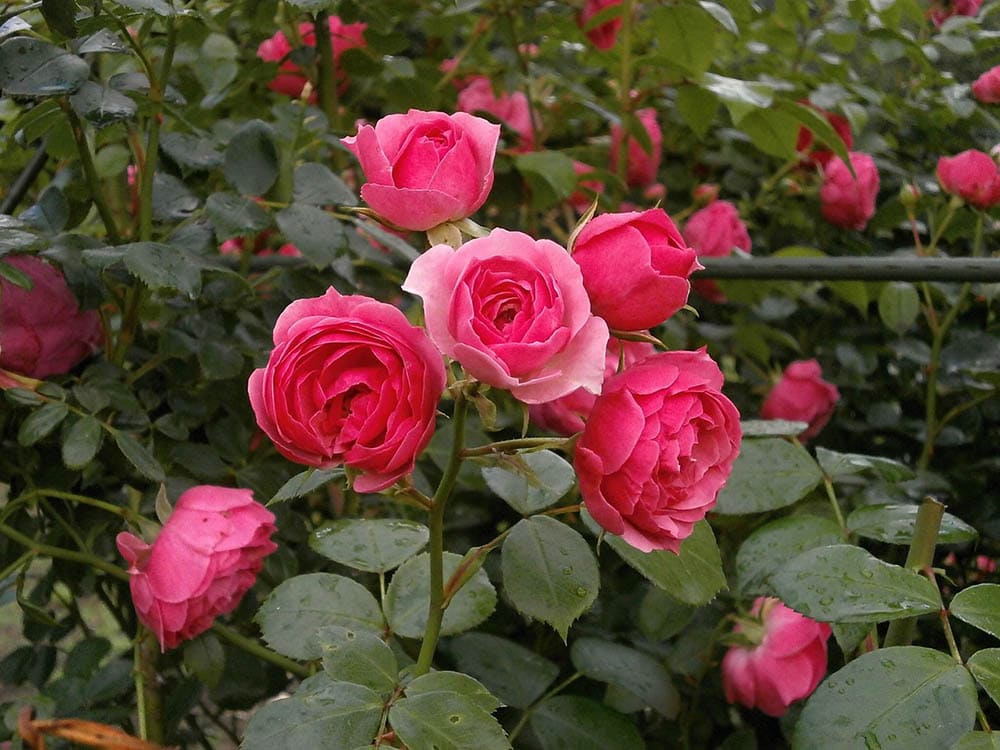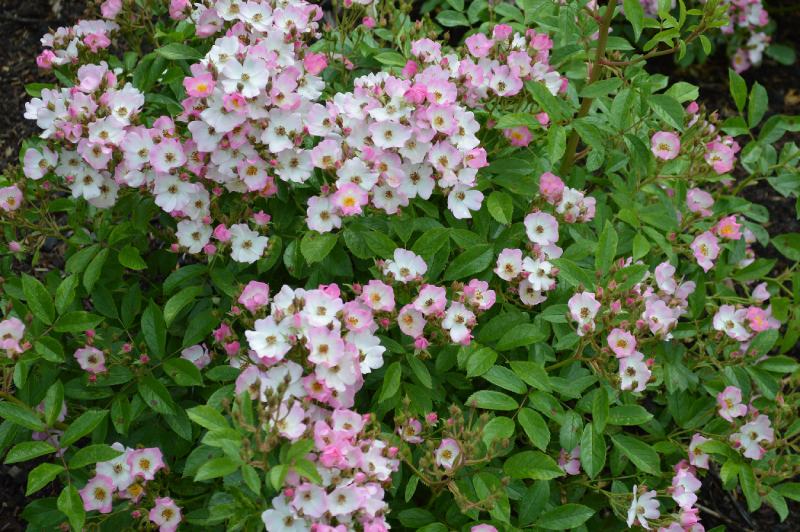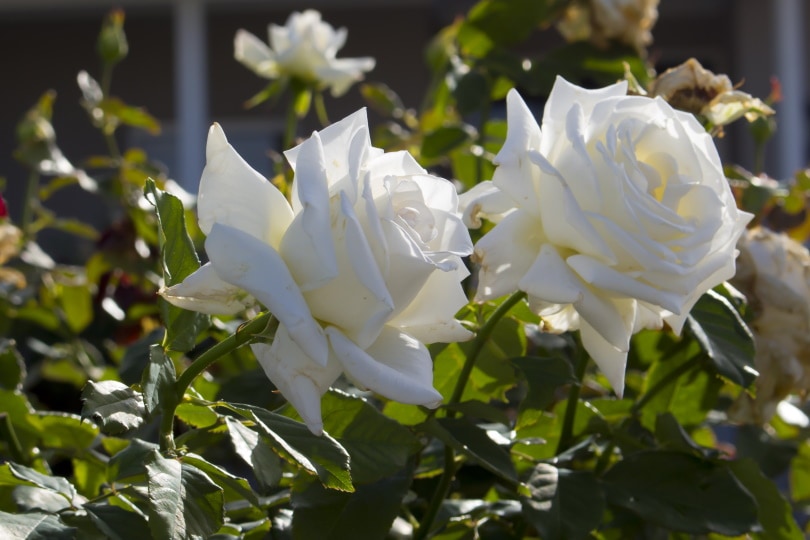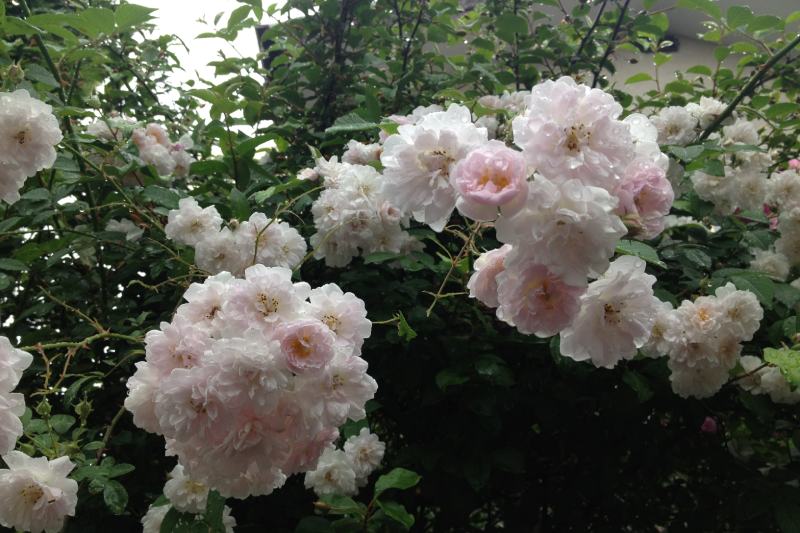23 Roses That Grow in Shade (With Pictures)
-

- Last updated:

Vibrant blooms, lush foliage, and delightful fragrances make roses of all kinds an impressive addition to any backyard garden. But if your landscaping is riddled with shady pockets, nurturing these sun-loving flowers to their fullest potential may seem out of the question.
Fortunately, motivated breeders have given us an array of roses that can handle less than 6 hours of daily direct sunlight. If you’re wondering how to maximize the aesthetic in the dimmer patches of your yard, we’ll discuss the best types of roses to grow in the shade.
Shade-covered roses will be less girthy and abundant than their sun-bathed counterparts, but that doesn’t make them any less breathtaking. Many bright rose colors that may get lost in full sun will radiate a striking glow in darker areas.
Given the attention that roses enjoy from growers around the globe, there are countless varieties of Old Garden, wild, and modern roses.
- Hybrid Tea: Long-stemmed plants with massive blooms that make excellent cut flowers
- Polyantha: Low-growing, low-maintenance plants with clusters of small blooms that are good for hedges and edgings
- Floribunda: Short, easy-to-maintain hybrid tea/polyantha crosses with continuous clusters of blooms for beds and borders
- Grandiflora: Tall-growing and hardy crosses between hybrid tea and floribunda roses
- David Austin English Rose: Hardy varieties combining old rose fragrance with continuous blooming and modern rose coloration
- Hybrid Musk: Disease-resistant and fragrant plants with repeating clusters of medium-sized blooms on long, arching stems
- Rugosa: Cold-tolerant, disease-resistant, and generally low-maintenance shrubs that produce large fruits after flowering
- Climbing Rose: Shrubs that produce large blooms on long, stiff stems you can train up arches, trellises, and walls
Many of these roses are modern species that show continuous or repeat-flowering habits. Rather than bloom one time in late spring, they display flowers throughout the growing period.
The 23 Roses That Grow in Shade
Roses can show up anywhere, whether as ground cover, garden shrubs, or fence climbers. Categorization has become confusing over the years with the wealth of hybrids hitting the market, so to give you the best chance of getting gorgeous growth, get started with these 23 shade-tolerant roses.
1. Ballerina Rose (Rosa Ballerina)

| Hardiness zone: | 5–10 |
| Growth height: | 4–6 feet |
| Rose type: | Hybrid musk |
The award-winning Ballerina rose shows off dense bunches of five-petaled pink and white flowers all summer long. Though the inch-long petals are delightfully delicate, the plant is hardy and easy to maintain. You can train the long-stemmed ‘Ballerina’ to climb up short runs, use it in a border, or plant it as a ground cover.
2. Carefree Wonder Rose (Rosa Carefree Wonder)
| Hardiness zone: | 4–9 |
| Growth height: | 3–4 feet |
| Rose type: | Floribunda |
Carefree Wonder is an aptly named landscape shrub. It doesn’t require much attention to produce its hot pink semi-double flowers. Blooms grow in tight clusters, giving you a dense show of color you can bring to containers, hedges, borders, or mixed beds.
3. The Lark Ascending Rose (Rosa The Lark Ascending)

| Hardiness zone: | 5–9 |
| Growth height: | 5 feet |
| Rose type: | English rose |
A charming cut flower, The Lark Ascending produces semi-double blossoms in warm pinkish apricot colors with a glowing gold core. The elegant cupped flowers grow atop tall shrubs but maintain space between one another to create a handsome display. Keep your nose peeled for a gentle shifting aroma that transitions from tea to myrrh as the roses mature.
4. Eden Climber Rose (Rosa Eden)
| Hardiness zone: | 5–10 |
| Growth height: | 8–10 feet |
| Rose type: | Climbing rose |
The Eden Climber rose is a short climber, and it presents its showy double flowers as high as 10 feet in the air, catching anyone’s attention at a distance. Massive cup-shaped blooms flash a stunning transition of color, starting as green buds before turning to creamy whites and yellows and finally a mid-toned pink. These prized repeat bloomers are versatile growers you can train up walls, fences, pillars, and more.
5. Eustacia Vye (Rosa Eustacia Vye)
| Hardiness zone: | 4–11 |
| Growth height: | 4 feet |
| Rose type: | English rose |
Bold and beautiful, Eustacia Vye blooms are some of the most captivating sights you can add to the garden. The full cupped flowers have a soft gradient of ruffled petals, with white and light pink edges intensifying and transitioning into an apricot center. The repeat-blooming English rose supplies a potent, fruity scent, making it perfect for nearby patio containers.
6. Claire Austin Rose (Rosa Claire Austin)
| Hardiness zone: | 5–11 |
| Growth height: | 12 feet |
| Rose type: | Climbing rose |
Named after David Austin’s daughter, the singular Claire Austin rose deserves the honor. The repeat-flowering plant offers gorgeous white and peach coloration and a pungent myrrh and vanilla aroma throughout the summer. Train this agile climber around arches and doorways for a soothing sensory experience.
7. Princess Alexandra Of Kent Rose (Rosa Princess Alexandra Of Kent)
| Hardiness zone: | 5–9 |
| Growth height: | 3–4 feet |
| Rose type: | English rose |
The Princess Alexandra of Ken is so remarkable that it’s almost tragic it isn’t a tall, adventurous climber. Though it sits closer to the ground, its repeat-blooming flowers are hard to miss, featuring thick layers of deep pink petals in 4-inch cups. Add them to mixed borders or patio pots for sharp accents and a fragrance of tea.
8. Iceberg Rose (Rosa floribunda Iceberg)

| Hardiness zone: | 6–11 |
| Growth height: | 4 feet |
| Rose type: | Floribunda |
The Iceberg rose is another award winner, and it is a vigorous and versatile garden addition. Blooms can show up all summer long in short shrubs along borders and beds or trained up trellises and walls. The pure white, lightly double flowers are an attractive sight juxtaposed against the plant’s lush green foliage, not just for gardeners but also for nearby bee populations.
9. Hansa Rose (Rosa Hansa)
| Hardiness zone: | 3–8 |
| Growth height: | 5 feet |
| Rose type: | Rugosa |
The Hansa is as hardy as they come, and even though maintenance may be an afterthought, the stunning deep pink, fuchsia, and violet colors will be impossible to ignore. The 4-inch-wide flowers grow individually, but the separation allows the gorgeous greenery behind it to perfectly complement the purple petals. After the flowers recede, watch out for the enormous orange hips emerging in the fall.
10. Olivia Rose Austin Rose (Rosa Olivia Rose Austin)
| Hardiness zone: | 4–11 |
| Growth height: | 4–4.5 feet |
| Rose type: | English rose |
Subtle coloration makes the Olivia Rose Austin even more spectacular when set against its dark green foliage, especially when you put it in partial shade. Impossibly full double blooms offer flawless transitions of cloudy white fringes to a candy-pink core across 3-inch-wide cups. Flowers emerge early in spring, so you can count their familiar fruity fragrance among the quintessential signs of the season when you add them to patio pots or garden borders.
11. Kew Gardens Rose (Rosa Kew Gardens)
| Hardiness zone: | 5–11 |
| Growth height: | 4 feet |
| Rose type: | Hybrid musk |
The Kew Gardens rose is an explosion of single flowers across a thornless plant. Flowers are bright white with a hint of yellow at the stamen. The thick flowering growth creates a snow-covered effect across an impassable bush. At 4 feet tall, the dense shrub makes a perfect hedge or border.
12. Red Knock Out Rose (Rosa Radrazz)
| Hardiness zone: | 4–9 |
| Growth height: | 3–4 feet |
| Rose type: | Floribunda |
The Knock Out family of roses are crosses between a floribunda and a shrub-type rose. The Red Knock Out is the original cross, and it’s an exceptionally low-maintenance and disease-resistant cultivar that produces extraordinary cherry red blooms from early spring through the fall. With foliage as magnificent as the semi-double flowers, it’s no wonder why these easy-going roses are so celebrated.
13. Fair Bianca (Rosa Fair Bianca)
| Hardiness zone: | 4–9 |
| Growth height: | 2–3 feet |
| Rose type: | English rose |
Crisp white flowers and a strong, spicy scent will brighten even the shadiest patches of your backyard when you add the Fair Bianca to your landscaping. The repeat-blooming flowers hold a thick arrangement of petals within a 3-inch-wide cup. These roses work well in space-restricted areas like hedges, patio containers, or borders, requiring moderate maintenance for the best blooms.
14. Anthony Meilland Rose (Rosa floribunda Anthony Meilland)
| Hardiness zone: | 5–10 |
| Growth height: | 2–4 feet |
| Rose type: | Floribunda |
Grand, unfading yellow flowers bring a sunshine glow to even the darkest corners of the garden. Continuous blooming clusters feature full double flowers of up to 40 petals and a delicate scent. The Anthony Meilland rosemakes a perfect border accent or standalone display in a garden bed.
15. Malvern Hills Rose (Rosa Malvern Hills)
| Hardiness zone: | 5–11 |
| Growth height: | 15 feet |
| Rose type: | English rambling rose |
Rambling roses are soaring, expansive rose bushes you can train up arches, pillars, and similar structures. Though ramblers traditionally bloom once per season, breeder David Austin’s touch turned the Malvern Hills into a sky-high, repeat-flowering wonder. The soft creamy yellow blooms are petal-ridden but small, appearing in concentrated clusters to lighten up vast spreads of shade.
16. Marmalade Skies Rose (Rosa floribunda Marmalade Skies)
| Hardiness zone: | 5–9 |
| Growth height: | 3 feet |
| Rose type: | Floribunda |
The Marmalade Skies rose surprises with marvelous semi-double blooms in rich tangerine orange hues. Tight clusters of flowers adorn compact shrubs, making natural bouquets ready to move from stem to vase with minimal fuss. Plants bloom all season in eager abundance, an excellent way to show off with garden borders.
17. Gruss an Aachen Rose (Rosa floribunda ‘Gruss an Aachen’)
| Hardiness zone: | 4–9 |
| Growth height: | 3–4 feet |
| Rose type: | Floribunda |
Compact and casual, Gruss an Aachen is a short-growing continuous bloomer perfect for filling out borders and hedges. A scent as light as its varied salmon pink and peach-colored flowers make the attractive clusters of double blooms a highlight in any shaded area.
18. Mary Rose Rose (Rosa Mary Rose)
| Hardiness zone: | 4–11 |
| Growth height: | 4–5 feet |
| Rose type: | English rose |
A classic in every sense, the loose, mid-pink ruffles of the Mary Rose emit a gorgeous perfumey scent true to the grandest traditions of Old Rose aromas. The repeat-flowering show of double blooms brings the mint-green foliage to life. Even in the shadiest areas, you can easily add a bold, bright, and beautiful blanket of color to your garden beds.
19. Paul’s Himalayan Musk Rose

| Hardiness zone: | 4–8 |
| Growth height: | 20–30 feet |
| Rose type: | Rambling rose |
The Paul’s Himalayan Musk rose rockets to heights of up to 40 feet, and the massive plant is unlikely to have any sunlight issues. But if this heirloom, once-blooming rambler is somehow overtaken by a taller tree, it can tolerate enough shade to pull off dazzling large lilac-colored blooms in the summer months.
20. New Dawn Rose (Rosa New Dawn)
| Hardiness zone: | 5–9 |
| Growth height: | 10–15 feet |
| Rose type: | Climbing rose |
Growing up 15 feet tall and aggressively blooming from summer through the fall, the New Dawn rose wants to show off. These disease-resistant roses send out bunches of double-flowering pale pink blossoms against deep green foliage. Grow them over arches or along fences to impart a spread of fruity aromas.
21. Passionate Kisses Rose (Rosa floribunda Passionate Kisses)
| Hardiness zone: | 5–9 |
| Growth height: | 3–4 feet |
| Rose type: | Floribunda |
Passionate Kisses roses are adaptable plants perfect for borders, beds, hedges, or any random shady spot in your yard. The double blooms present unique shades of coral and salmon pinks atop lush green bushes, a splendid arrangement you’ll enjoy for months.
22. Playboy Rose (Rosa Playboy)

| Hardiness zone: | 4–9 |
| Growth height: | 3–4 feet |
| Rose type: | Floribunda |
A solar flare burst of orange and scarlet semi-double flowers accompanies an apple aroma to make one of the most exciting garden additions for shade-filled corners. Shiny green foliage is the perfect contrast to the intense warm flowers. The Playboy rose is cold-hardy and disease-resistant, and it can handle the occasional missed watering. Use this continuous bloomer to form cheery runs of borders and hedges.
23. Seafoam Rose (Rosa floribunda Seafoam)
| Hardiness zone: | 4–9 |
| Growth height: | 2–3 feet |
| Rose type: | Floribunda |
Seafoam rose bushes may only grow a few feet tall as a shrub, but you can also train them to grow or trail, giving you several ways to fill your space. The bright semi-double flowers illuminate dimly lit patches with a continuously blooming spread of white. The Seafoam is an exceptional landscape rose, and it’s adaptable as a ground cover, climber, or standalone shrub.
Tips for Growing Roses in the Shade
Although one rose variety may be more shade-tolerant than others, remember that roses generally love full sun. Even the ones listed here need at least 4-5 hours of sunlight each day to produce a decent display of flowers. Try to identify areas that get the best sunlight in the brightest midseason days and the less sunny spring and fall months.
Although you’re growing roses in the shade, you don’t want them competing with trees and other plants for water and nutrients. Roses grown in the shade generally need less water, but you should still try to keep them at least 2 feet away from the nearest tree trunk. Mulch them with nutrient-rich compost or manure on newspaper layers to replenish nitrogen and essential nutrients while improving water retention.
Roses won’t grow as thick in the shade as in the sunlight, but you can help them meet their full potential by pruning the canes. If you can’t find a decent spot away from other plants, consider growing your roses in containers instead.
Conclusion
A shade-filled backyard may be pleasant for you, but it doesn’t benefit many garden plants. When you’re trying to beautify the duller sections of your lawn, these shade-tolerant rose varieties can supply some much-needed vigor and vibrancy. Check out the opportunities in your garden today, and see how you can complete your aesthetic with the bright-blooming display of color that only a rose can provide.
Featured Image Credit: RococoNeko, Pixabay
Contents

